The pope is not the only leader in the Catholic Church. The Catholic Church, like every structured environment — from governments to corporations to schools to sports programs — has a chain of command. Want to know who’s who in the Catholic Church? The table that follows gives you a quick look at who’s in charge, from highest (the pope) to lowest (top to bottom) in terms of rank.
| Clergy Members' Titles | What They Do |
|---|---|
| The pope | He’s the bishop of Rome and the head of the whole church. |
| Cardinals | They elect the pope and work in different departments as his right-hand men. |
| Bishops and archbishops | They take charge of the churches in their respective geographical areas, called dioceses. |
| Vicar generals | They are priests who help the bishop govern the local churches. |
| Parish priests, or pastors | They take care of all the big day-to-day duties in their churches, from leading Mass to hearing confessions. |
| Monks and nuns | They choose to live together, work together, and spend many hours devoted in prayer. |
The government of the Catholic Church, called the hierarchy, is more like a monarchy than a democracy. Catholicism is hierarchical in that one person, the pope, is supreme head over the universal Church. Yet bishops govern the local churches in a geographical district called the diocese, and pastors (or priests) represent the bishop in each local parish. Individual Catholics don’t vote for the next pope or for their bishop or pastor.
The Catholic hierarchy operates like a military chain of command as opposed to an elected, representative government.

